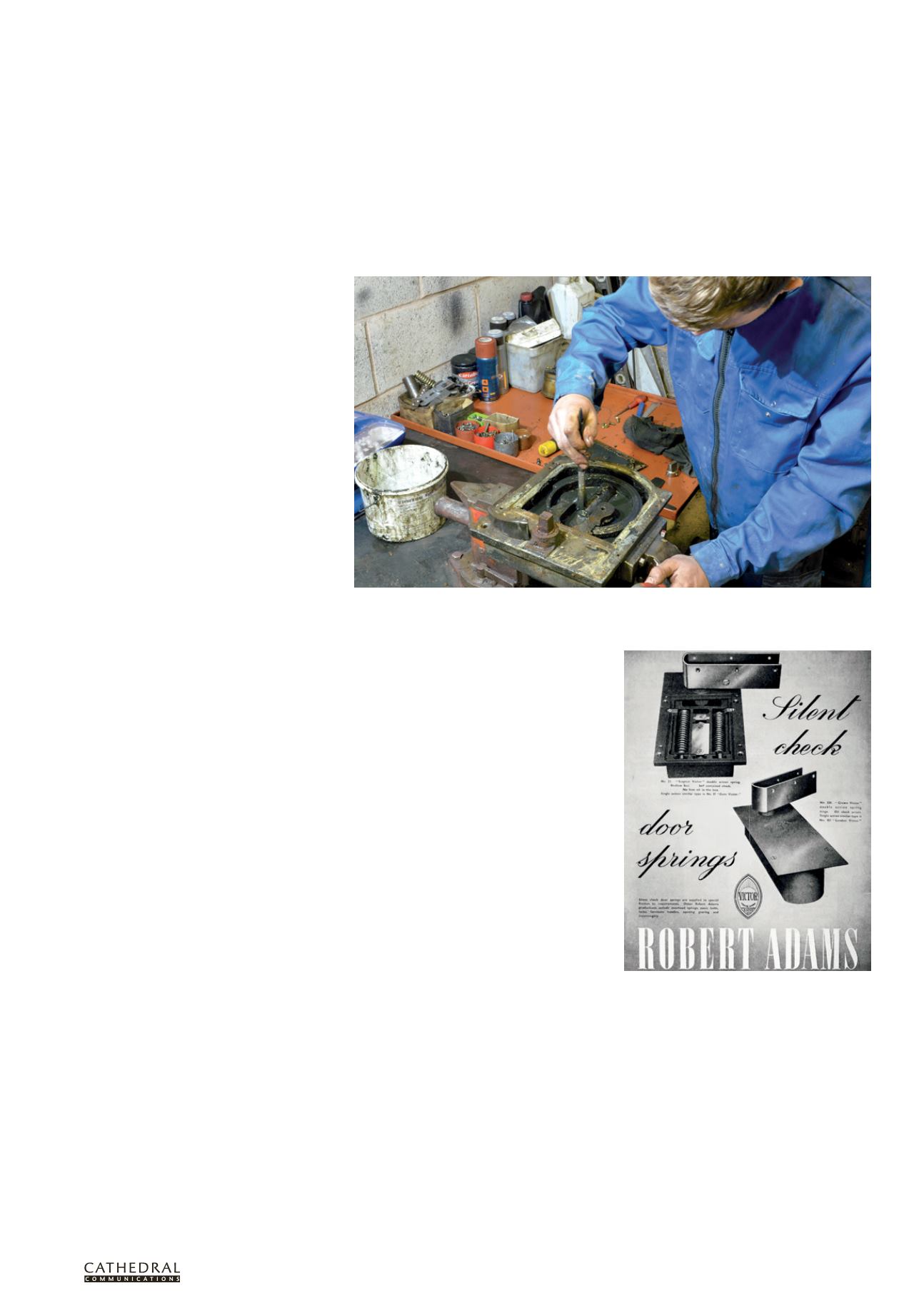

T W E N T Y T H I R D E D I T I O N
T H E B U I L D I N G C O N S E R VAT I O N D I R E C T O R Y 2 0 1 6
1 1 9
3.3
STRUCTURE & FABR I C :
ME TAL ,
WOOD & GLASS
FLOOR-SPRING DOOR CLOSERS
A hidden world beneath your feet
ROD FATHERS
D
OOR CLOSERS
perform a number
of useful functions and will serve
faithfully for many years if properly
maintained. They save energy by minimising
heat loss, prevent accidents by ensuring
that heavy doors don’t slam shut suddenly,
aid security by ensuring that doors latch
automatically and prevent the spread of fire by
keeping internal doors closed.
Traditional floor springs and door closers
have become victims of their own success.
They are such simple, effective and reliable
devices that we only tend to notice them if
they fail. Efforts to repair and maintain them
almost invariably result in modern suppliers
explaining that the only option is to fit a new
one. As a result, historic door closers are
frequently replaced with new, characterless,
often inferior, modern products without
further thought. Yet they are part of the
character and significance of the interior.
Many are over 100 years old and of historic
significance in their own right.
MAIN TYPES
There are three main types of door closer:
surface-mounted (the most common),
overhead or transom door closers (concealed
in the header or transom of the door frame),
and the most reliable and long lasting of all,
the floor-mounted door spring (known in the
trade as a floor spring).
Surface-mounted door springs such as the
Briton, which is still common in old buildings,
are designed for doors that only open one
way and are known as single-action door
closers. Transom closers and floor springs are
manufactured for doors that can open either
inward or outward and are often collectively
referred to as double-action door closers.
There are also single-action variants of both
the transom closer and the floor spring which
are found mainly on entrance doors.
HISTORY
Door closers were probably invented
soon after door hinges. It is easy to
imagine a series of pulleys, a weight and
a length of twine used in combination
to automate the closing of a door.
One of the earliest documented
inventions for a door opening and closing
device was invented by Heron of Alexandria
(c10–70 AD). This ingenious mechanism used
heat, pneumatics and pulleys to automate the
opening of temple doors.
In the UK, all manner of varieties of door
closer have been found dating from the 17th and
18th centuries, but all those produced since
the advent of the Industrial Revolution have
used some sort of spring device to store the
energy produced when the door is opened so
that it closes again. For a floor spring, this was
achieved by supporting the bottom corner of the
door in a metal shoe with a socket which locates
on to a pin projecting from the device set in
the floor. The bottom of this pin attaches to
some form of spring mechanism concealed
below a brass plate. Early door closing devices
were clearly influenced by the clock-making
industry because many designs incorporated
a heavy-duty clock type spring at their heart.
Designs had become simpler and more effective
by the end of the Georgian period. However,
it was not until the late 19th and early 20th
centuries that door closers as we know them
were reliable enough to become standard fittings
on high traffic doors throughout the world.
It is documented that a Mr Smith invented
an early door closing device in 1770 at his
premises at 69 Princes Street, London, laying
the foundations for one of the most successful
companies in the following century, Archibald
Smith and Stevens. In the early 19th century
a succession of developments are recorded
and patented (see table). The transactions
of the Society Instituted at London for the
Encouragement of Arts, Manufactures and
Commerce records that a Silver Medal and
five guineas were awarded to a Mr James Stone
for his door spring invention of 1814. White’s
double door spring was invented in 1822, and
Edwin Showell & Sons was producing floor
springs from 1830.
Mid-19th century improvements by
FW Gerish and JM Aldridge to the design
of hinges resulted in many manufacturers
abandoning traditional door hinges in
favour of a top pivot. Very often these were
adjustable, many retracting into the header
with the turn of a slotted screw.
Early floor springs had no check devices,
and relied on friction to slow the speed of
the closing door. However, following the
introduction of pivots and improvements in
the bearings, some sort of mechanism was
needed to ‘check’ the speed of the door. Early
Connor Haywood of Midlands Floor Springs repairing a Leader floor spring with concentric horseshoe-shaped
springs, two of which are broken. The small device in the middle is a limiter which slows the speed of the closing
door by forcing oil through a small hole in the cylinder or ‘dashpot’.
The Victor range of Silent Check door springs from a
1950s advertisement: perhaps the Rolls Royce of floor
springs was the London Victor, patented by Robert
Adams in 1891.
















